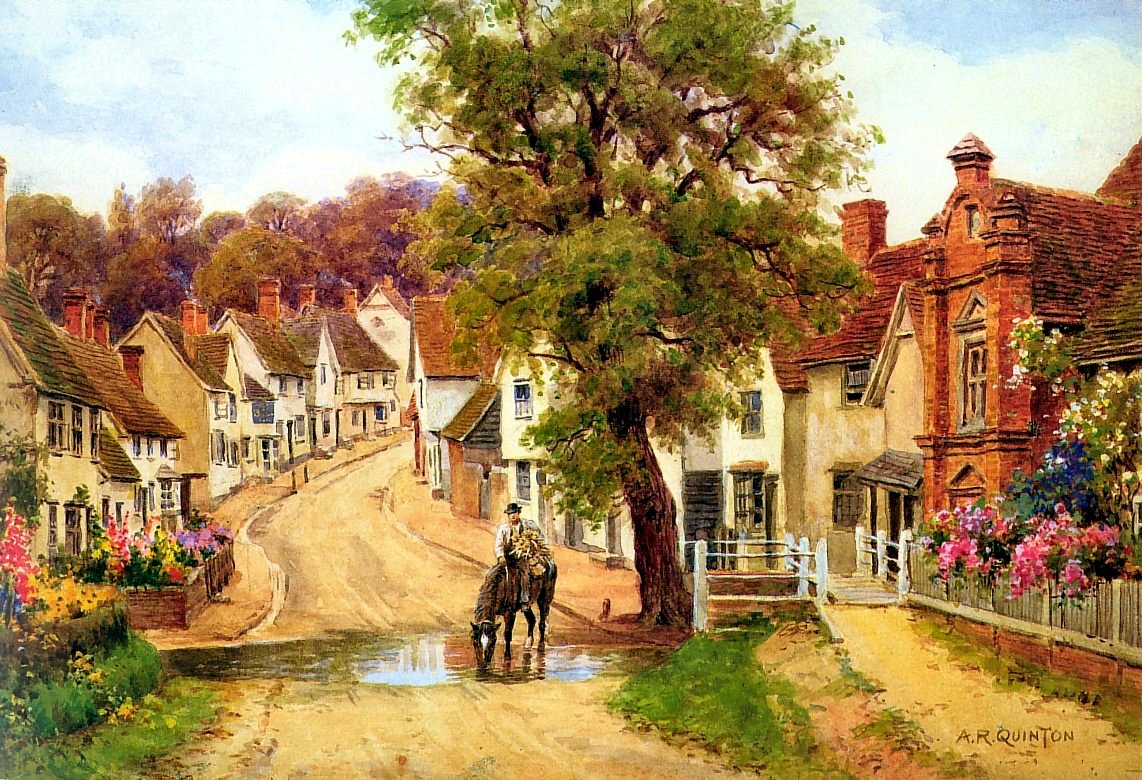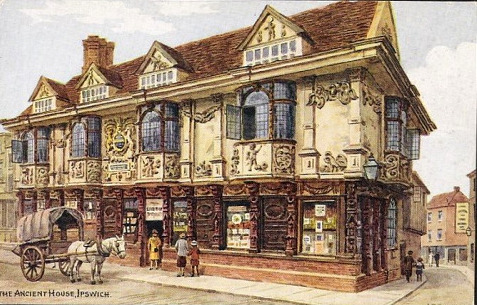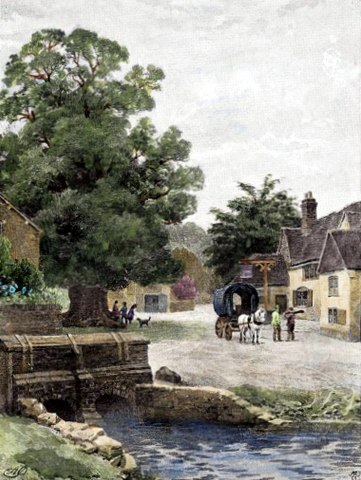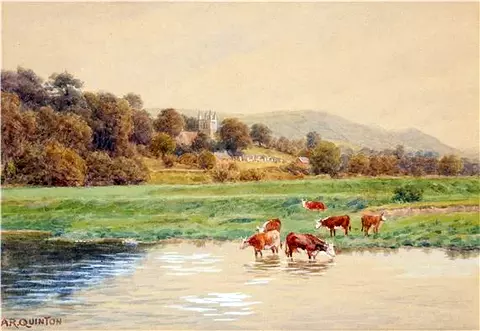QUINTON, Alfred Robert
Alfred Robert Quinton was born at Peckham, London on 28 October 1853, youngest of the seven children of John Allan Quinton (1817-13 March 1906), printer & editor of periodicals, and his wife Eliza Cullum (1817-1886), daughter of John Cullum of the Griffin Inn, Ipswich, who married at Ipswich on 8 July 1840 and were of the family of Quinton, chemists of Needham Market, near Ipswich. About 1851, Alfred's parents moved from Ipswich to 5 Ellington Terrace, Islington, London and Alfred's father, who learned the printing trade at Burton's printing office on the Cornhill, Ipswich, was editor for the Religious Tract Society, producing various publications including the 'Boys Own' and 'Girls Own' papers. Alfred was educated at Charterhouse and studied art at Heatherley School of Fine Art before working as a steel engraver, but the attraction of painting remained with him and he started to work in oils but from about 1874, in watercolour, with his first studio in Fleet Street and later at Lincoln's Inn, London. He exhibited at the Royal Academy 1879-1919, but later work was banned by the Academy because they disapproved of his 'commercialisation' of art. He also exhibited at the Ipswich Fine Art Club from 12 New Court, Lincoln's Inn in 1882, three watercolours 'Marine Villa', 'At Walberswick, Suffolk' and 'Surrey Farmyard' and in 1883 an oil 'Spring Time, Surrey' and two watercolours 'Evening at Walberswick, Suffolk' and 'On the Beach, Polperro, Cornwall'. He also exhibited at the Royal Society of British Artists from 1877, including in 1881 from the same address, two watercolours his 'Evening at Walberswick' also 'A Sketch at Walberswick'. He married at Bolton, Lancashire on 20 May 1885, 27-year-old Elizabeth Annie Crompton (1858-16 February 1945) and in 1891, was an 'artist painter' living at Burleigh Villas, 20 Fortis Green Road, Finchley with their 5-year-old son Leonard, born at Hampstead on 5 March 1886. In 1895, Alfred set out with a friend to cycle from Land's End to John O'Groats writing of his experiences and illustrating the work with his own drawings which were serialised in the 'Illustrated Sporting and Dramatic News'. As his work became more profitable, he was able to purchase a house with sufficient room to have a studio at home, and in 1911, was living at Westfield, Salisbury Avenue, Finchley with his 52-year-old wife and two sons Leonard 25 and Edgar Allan 19. He settled into the pattern of travelling for up to three months of the year, during the summer, making sketches and taking photographs then spending the winter months transferring what he had seen into paintings. He was commissioned to provide illustrations for other publications, including Ditchfield's 'The Cottage and Village Life of Rural England' for which he provided 71 pictures also providing pictures for another of Ditchfield's books 'The City Companies of London and their Good Works' but perhaps most significant was the work 'The Historic Thames' for which Hilaire Belloc wrote the text. The postcard publisher Raphael Tuck began to produce images from Quinton's watercolours in a series called 'Village Crosses' however, another publisher Joseph R. Salmon of Sevenoaks in Kent, already producing a series of post cards, employing local artists to produce pictures of their neighbourhoods, but the work of Alfred Quinton came to his attention when he approached Quinton to travel specifically to record picturesque places in Britain which became a productive partnership. Alfred worked in England and Wales right through the First World War and produced in the region of 2,000 views for Salmon. Quinton also exhibited at Birmingham Royal Society of British Artists; Dudley Gallery; Dowdeswell Gallery; Grosvenor Gallery; Walker Art Gallery; Manchester City Art Gallery; Royal Society of British Artists; Royal Hibernian Academy; Royal Institute of Painters in Water Colour and the Royal Institute of Oil Painters. His original paintings for the Thames book and two of his works were purchased by the Duke and Duchess of Kent. His youngest son Edgar died in 1912, aged just 21, and Alfred Robert Quinton died at 'Westfield', 1 Salisbury Avenue, Finchley, London on 10 December 1934, aged 81 and his wife followed on 16 February 1945, aged 86, and eldest son Leonard died on 14 January 1981. He signed his works 'A. R. Quinton'. (Copsey-Suffolk Book Trades (Ipswich 2011) and 'The Rural England of A R Quinton' (London 1978).
Royal Academy Exhibits
from 10 Bolt Court, Fleet Street, London
1879 683 At Gomshall, Surrey - watercolour
from 12 New Court, Lincoln's Inn
1880 577 Beside the Still Waters - watercolour
858 A Cottage Door - watercolour
1899 1038 Sussex Woodlands - watercolour
1099 The Heart of Sussex - watercolour
1900 1155 Henley, Sussex - watercolour
1173 Blackdown from Henley Hill - watercolour
1902 799 The Thames Valley, from Henley Park - watercolour
from 20 Forti-green Road, East Finchley, North London
1907 925 Clieveden Woods - watercolour
1019 The Thames Valley, from above Streetley - watercolour
from 1 Salisbury Avenue, Finchley, North London
1909 839 The Valley of the Avon and Bredon Hill - watercolour
1912 1059 Sussex Woodlands - watercolour
1914 1395 A Sussex Landscape - watercolour
1915 1163 Reaping Barley, Sussex - watercolour
1918 695 The Road over the Downs, Sussex - watercolour
1919 775 Bredon Hill, Worcestershire - watercolour
Works by This Artist

|
Kersey, SuffolkWatercolour |

|
The Ancient House, IpswichPostcard |

|
Shere VillageWatercolour
|

|
Glasbury Church from the WyeWatercolour and gum Arabic on paper
|